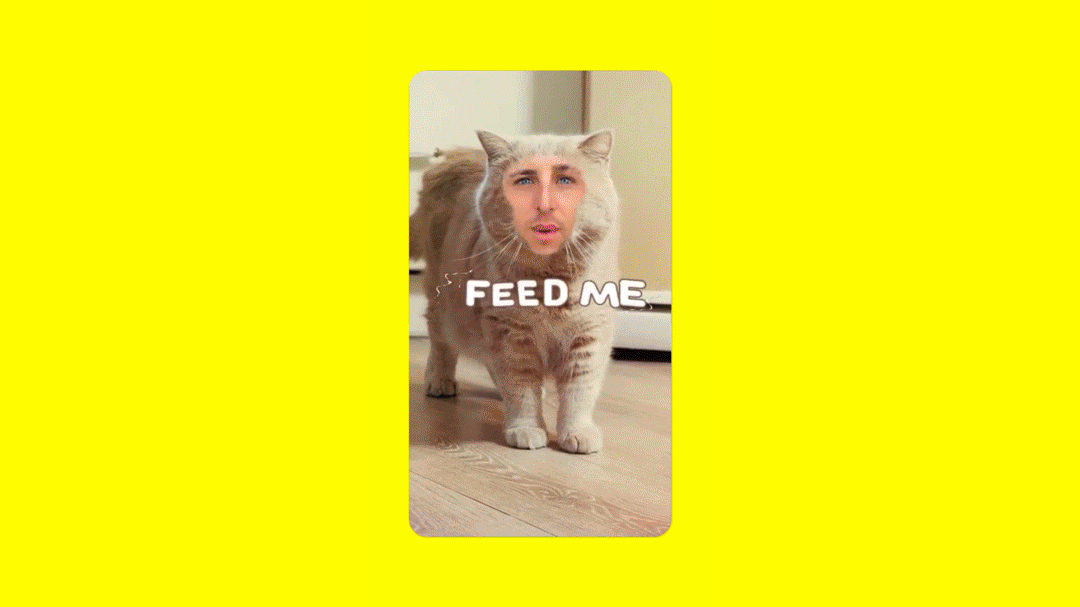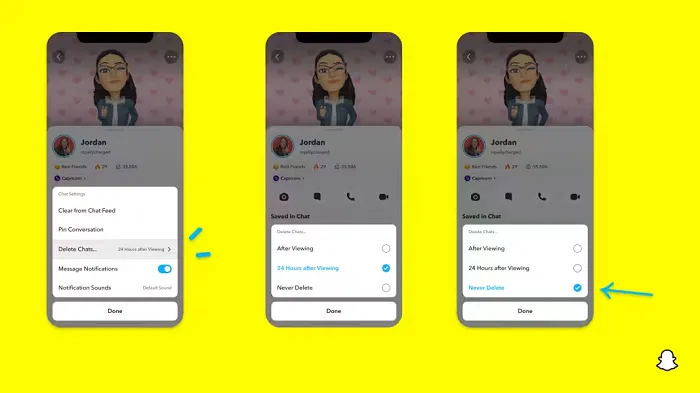SOCIAL
Snapchat and TikTok are Both Reportedly Working on New ‘Deepfake’ Type Features

Will 2020 be the year that deepfakes go mainstream?
It’s only the first week of the year, and we’ve seen two new advances on this front, with Snapchat acquiring computer vision start-up AI Factory for $166 million, and images which show that TikTok is working on a deepfake-style addition within its app, enabling users to create videos with their own face overlaid onto pre-recorded footage.
First off, on Snapchat – Snap has reportedly purchased AI Factory, which is the company it worked with in developing its recently launched Cameo feature, which enables users to overlay their face over a selection of pre-made scenes.

The acquisition would suggest that Snapchat will be looking to advance further along this path, improving its capacity to overlay your image onto video content.
TikTok, meanwhile, as per TechCrunch, is working on a more direct deepfake-style feature, which asks users to take a multi-angle, biometric scan of their face, then enables them to add their image into a selection of videos.

The tool looks similar to video editing app ZAO, which enables users to upload their image to a range of movie scenes.
In case you haven’t heard, #ZAO is a Chinese app which completely blew up since Friday. Best application of ‘Deepfake’-style AI facial replacement I’ve ever seen.
Here’s an example of me as DiCaprio (generated in under 8 secs from that one photo in the thumbnail) ???? pic.twitter.com/1RpnJJ3wgT
— Allan Xia (@AllanXia) September 1, 2019
Both of these developments carry some level of concern – over the past few years we’ve seen significant advances in video technology, and in enabling users to overlay other people’s faces over existing video content.
Take, for example, the Bill Hader/Tom Cruise morphing video:
Or this video depicting Donald Trump as every youngster from the show ‘Toddlers in Tiaras’.
They still don’t look one hundred percent, there are still some elements where the edges blur or glitch slightly. But it’s clear that the technology is improving fast, and while these examples are just for fun, for entertainment online, it’s not hard to imagine the same technology being used for more nefarious purpose, like showing a politician saying something he didn’t, or depicting a business leader or celebrity in a compromising position.
And what’s worse, even if such a video were proven to be fake in retrospect, once that initial damage is done, it could be too late. The potential for harm via such process is significant.
That’s why Facebook, Google and Twitter independently are all conducting pre-emptive research into how to detect and highlight deepfakes to avoid misinterpretation. Which makes it a little odd that TikTok and Snapchat are working to facilitate variations of the same into their native tools.
For Snapchat’s part, its Cameo feature is more cartoonish, more based in animation than reality, so it’s hard to see it being used for such purpose. TikTok’s variation is more concerning – and worse, the biometric data uploaded within TikTok (or more specifically the Chinese version of the app ‘Douyin’) for such purpose could be accessed by the Chinese Government for use in identification purposes.
China’s advanced surveillance measures have already been criticized by human rights groups, with Chinese authorities reportedly using digital face scans to track and control the activities of Uighur Muslims in the country. China’s citizen surveillance network comprises of over 170 million CCTV cameras – the equivalent of one for every 12 people in the country – which are all, reportedly, being equipped with advanced facial recognition capacity.
Uploading your face scan data to Douyin seems like a surefire path to the Chinese Government accessing that data, and utilizing such for tracking purposes.
When contacted by TechCrunch on the new feature, TikTok’s parent company ByteDance denied that this deepfake-style option would ever be coming to TikTok.
As per ByteDance:
“This is definitely not a function in TikTok, nor do we have any intention of introducing it. I think what you may be looking at is something slated for Douyin – your email includes screenshots that would be from Douyin, and a privacy policy that mentions Douyin.”
So just for Chinese users then, not for TikTok. TechCrunch notes that the documentation for the new feature was definitely available within TikTok, which would suggest that, at some stage at least, it was being planned for a broader roll-out. But it seems, right now, that only Chinese users will be getting the tool.
Which, as noted above, probably doesn’t make it any better. Definitely, there are interesting, entertaining applications for deepfake-style tools out there, and you can imagine they’d prove very popular in either app. But there are also significant risks in making such so readily available.
But then again, similar tools are already available in other apps – so should TikTok and Snapchat miss out on that engagement when people can already use the same elsewhere? What responsibility should each platform have for facilitating potential misuse in this respect?
There are no easy answers, and the fact remains that deepfakes, as we’ve been warned by all the major tech players, are going to become a problem.
Now we need to rely on those same platforms to provide us with advanced detection tools to avoid potential impacts.
SOCIAL
Snapchat Explores New Messaging Retention Feature: A Game-Changer or Risky Move?

In a recent announcement, Snapchat revealed a groundbreaking update that challenges its traditional design ethos. The platform is experimenting with an option that allows users to defy the 24-hour auto-delete rule, a feature synonymous with Snapchat’s ephemeral messaging model.
The proposed change aims to introduce a “Never delete” option in messaging retention settings, aligning Snapchat more closely with conventional messaging apps. While this move may blur Snapchat’s distinctive selling point, Snap appears convinced of its necessity.
According to Snap, the decision stems from user feedback and a commitment to innovation based on user needs. The company aims to provide greater flexibility and control over conversations, catering to the preferences of its community.
Currently undergoing trials in select markets, the new feature empowers users to adjust retention settings on a conversation-by-conversation basis. Flexibility remains paramount, with participants able to modify settings within chats and receive in-chat notifications to ensure transparency.
Snapchat underscores that the default auto-delete feature will persist, reinforcing its design philosophy centered on ephemerality. However, with the app gaining traction as a primary messaging platform, the option offers users a means to preserve longer chat histories.
The update marks a pivotal moment for Snapchat, renowned for its disappearing message premise, especially popular among younger demographics. Retaining this focus has been pivotal to Snapchat’s identity, but the shift suggests a broader strategy aimed at diversifying its user base.
This strategy may appeal particularly to older demographics, potentially extending Snapchat’s relevance as users age. By emulating features of conventional messaging platforms, Snapchat seeks to enhance its appeal and broaden its reach.
Yet, the introduction of message retention poses questions about Snapchat’s uniqueness. While addressing user demands, the risk of diluting Snapchat’s distinctiveness looms large.
As Snapchat ventures into uncharted territory, the outcome of this experiment remains uncertain. Will message retention propel Snapchat to new heights, or will it compromise the platform’s uniqueness?
Only time will tell.
SOCIAL
Catering to specific audience boosts your business, says accountant turned coach

While it is tempting to try to appeal to a broad audience, the founder of alcohol-free coaching service Just the Tonic, Sandra Parker, believes the best thing you can do for your business is focus on your niche. Here’s how she did just that.
When running a business, reaching out to as many clients as possible can be tempting. But it also risks making your marketing “too generic,” warns Sandra Parker, the founder of Just The Tonic Coaching.
“From the very start of my business, I knew exactly who I could help and who I couldn’t,” Parker told My Biggest Lessons.
Parker struggled with alcohol dependence as a young professional. Today, her business targets high-achieving individuals who face challenges similar to those she had early in her career.
“I understand their frustrations, I understand their fears, and I understand their coping mechanisms and the stories they’re telling themselves,” Parker said. “Because of that, I’m able to market very effectively, to speak in a language that they understand, and am able to reach them.”Â
“I believe that it’s really important that you know exactly who your customer or your client is, and you target them, and you resist the temptation to make your marketing too generic to try and reach everyone,” she explained.
“If you speak specifically to your target clients, you will reach them, and I believe that’s the way that you’re going to be more successful.
Watch the video for more of Sandra Parker’s biggest lessons.
SOCIAL
Instagram Tests Live-Stream Games to Enhance Engagement

Instagram’s testing out some new options to help spice up your live-streams in the app, with some live broadcasters now able to select a game that they can play with viewers in-stream.
As you can see in these example screens, posted by Ahmed Ghanem, some creators now have the option to play either “This or That”, a question and answer prompt that you can share with your viewers, or “Trivia”, to generate more engagement within your IG live-streams.
That could be a simple way to spark more conversation and interaction, which could then lead into further engagement opportunities from your live audience.
Meta’s been exploring more ways to make live-streaming a bigger consideration for IG creators, with a view to live-streams potentially catching on with more users.
That includes the gradual expansion of its “Stars” live-stream donation program, giving more creators in more regions a means to accept donations from live-stream viewers, while back in December, Instagram also added some new options to make it easier to go live using third-party tools via desktop PCs.
Live streaming has been a major shift in China, where shopping live-streams, in particular, have led to massive opportunities for streaming platforms. They haven’t caught on in the same way in Western regions, but as TikTok and YouTube look to push live-stream adoption, there is still a chance that they will become a much bigger element in future.
Which is why IG is also trying to stay in touch, and add more ways for its creators to engage via streams. Live-stream games is another element within this, which could make this a better community-building, and potentially sales-driving option.
We’ve asked Instagram for more information on this test, and we’ll update this post if/when we hear back.
-

 SEO7 days ago
SEO7 days agoGoogle Limits News Links In California Over Proposed ‘Link Tax’ Law
-

 SEARCHENGINES6 days ago
SEARCHENGINES6 days agoGoogle Core Update Volatility, Helpful Content Update Gone, Dangerous Google Search Results & Google Ads Confusion
-

 SEO6 days ago
SEO6 days ago10 Paid Search & PPC Planning Best Practices
-

 MARKETING7 days ago
MARKETING7 days ago2 Ways to Take Back the Power in Your Business: Part 2
-

 MARKETING5 days ago
MARKETING5 days ago5 Psychological Tactics to Write Better Emails
-

 SEARCHENGINES5 days ago
SEARCHENGINES5 days agoWeekend Google Core Ranking Volatility
-

 PPC7 days ago
PPC7 days agoCritical Display Error in Brand Safety Metrics On Twitter/X Corrected
-

 MARKETING6 days ago
MARKETING6 days agoThe power of program management in martech

